Same age German "Mauser": Russian rifle 1891 of the year. Questions and answers. Chapter two
Why was the “3 linear rifle of the 1891 model of the year” not used without a bayonet?
As a matter of fact, the chapter one could be stopped. But having learned why the three-lane was shot with a bayonet, we received a second question - why it was not envisaged to use a rifle without a bayonet. Therefore, we will not stop and refer to the 1884 “Instructions for Shooting Training”. It was valid until the “Manual ...” 1897 of the year we reviewed.
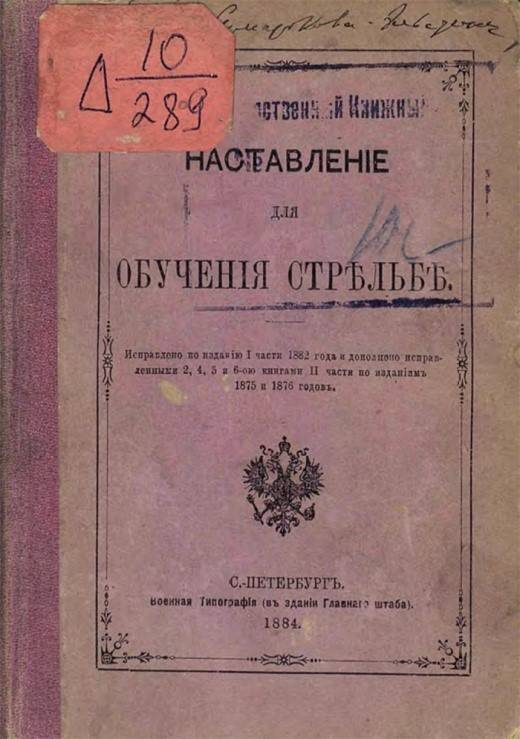
The Shooting Training Instruction 1884 of the Year.
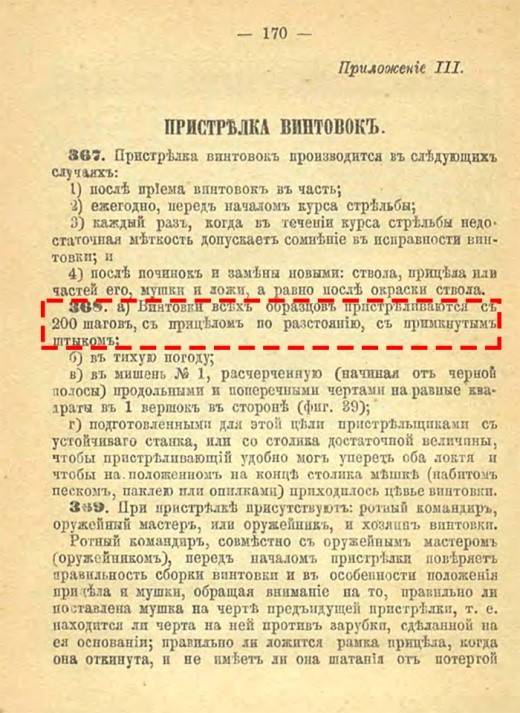
Open the 170 page of the specified manual. And what we see there.
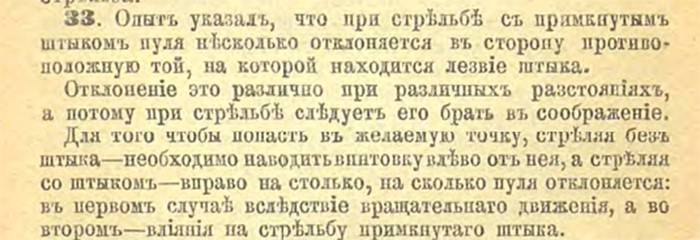
But what is written there about the influence of the bayonet on the flight of a bullet.
What kind of rifle was in service with the Russian Empire in the 1884 year? In 1884, the Russian Imperial Army was armed with the “Berdan No. 2 small-caliber rifle”. It turns out that the "rifle" had to be shot exclusively with a bayonet. As you can see, in the "Manual ..." 1884 of the year there is another indication.
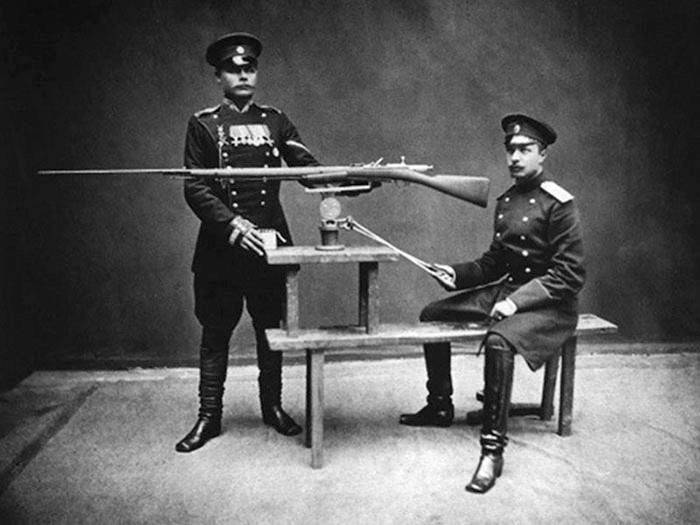
This is a photo of the test rifle Berdan №2. 1870 year. Experienced by her captain Gunius (standing) and Colonel Gorlov. Pay attention - a rifle with a bayonet. That is, Berdan’s rifle was originally intended to be used only with a bayonet.
But with the rifle Berdan №1 turned out somewhat more difficult. This is the first Russian rifle, which was originally designed as a breech-loading. This rifle was designed in the United States and shot without a bayonet.
But the very first tests in Russia put everything in its place. The rifle was tested, naturally, with a bayonet. Gorlov, at his discretion, chose a triangular bayonet for the rifle. But the triangular bayonet of the old design, created even for muzzle loading weapons, could not withstand the loads created by new ammunition. After that, a new, more durable tetrahedral bayonet was designed and everything fell into place. Because rifle Berdan №2, adopted in the 1870 year, has already received a new bayonet - four-sided. He, virtually unchanged, got and "3x-linear rifle sample 1891 of the year."
And how was it even earlier, before Berdan’s rifle No.2?
Before the rifle of Berdan # XXUMX in Russia, it was what military minister Dmitry Alekseevich Milyutin called "our unfortunate rifle drama."
The fact is that, thanks to the rapid development of science and technology in the second half of the 18th and the first quarter of the 19th century, the gun — the main armament of the infantryman and cavalryman — which had not changed at all for several generations, suddenly began to develop at a very rapid pace. And those who did not want to find themselves in the position of catching up had to develop, adopt and launch completely new constructions with no less speed.
And the Russian Empire during this period had a hard time. As Milutin said: "... the equipment went forward with such quick steps that before the proposed orders were tested, new requirements appeared and new orders were made."
From 1859 to 1866, the Armory Commission (previously the Committee for the Improvement of Fittings and Guns) tested more than 130 foreign and at least 20 domestic systems.
As a result, they adopted the Terry-Norman quick-fire capsule rifle reworked with the 1856 rifle of the year and were removed from service as obsolete in less than a year.
She was replaced by the Carle rifle - with the same success. And finally, in 1869, the main armament of the army was the Krnka rifle, and on navy took the Baranov rifle (it was released a little - about 10 copies). The following document speaks well about how difficult it was for an army with so many systems during the Russian-Turkish war of 000-1877.
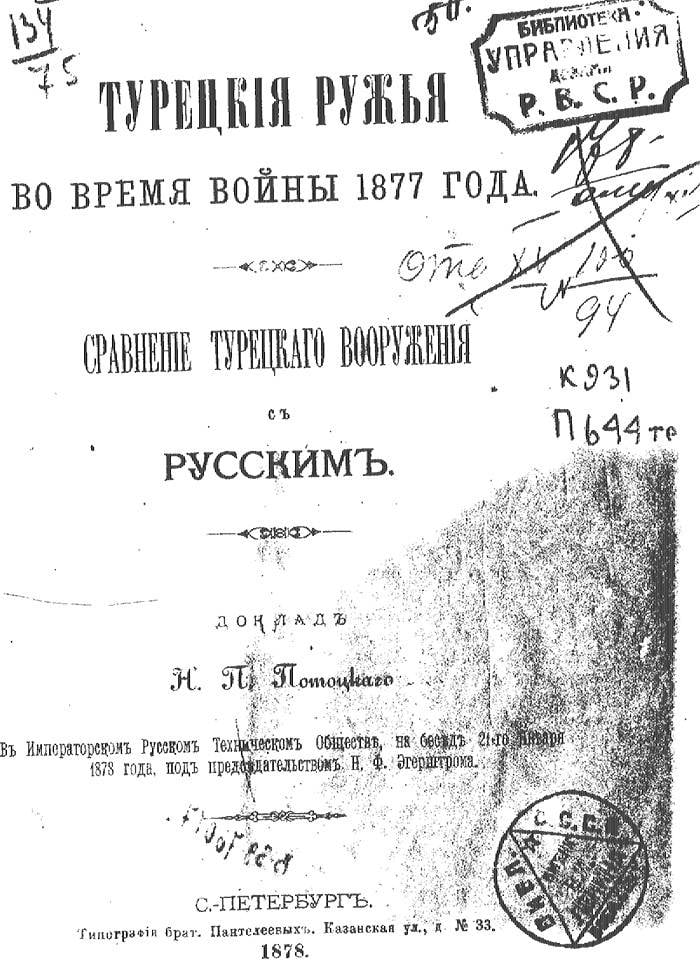
This is a famous report by General N.P. Potocki in the Imperial Russian Technical Society.
But in all of this at the moment we are interested in the question - and how were all these weapons models shot? And they shot with a bayonet. So, like the previous samples. Because without a bayonet infantry rifles are not used. And not only infantry.
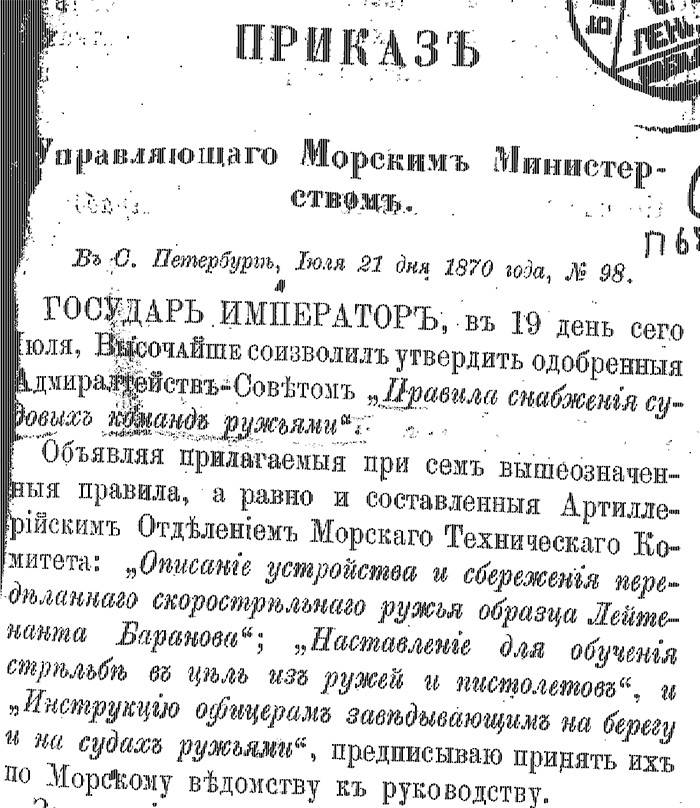
This is the Order of the Manager of the Maritime Ministry of 21 July 1870 of the year. This order determines the order of supplying the ship's commands with small arms. Attached to it is the "Instruction for learning to fire at a target with guns and pistols."
At this era of breech-rifled rifle we have exhausted. And what about a muzzle-loading, smooth-bore weapon?
Of course, we can’t talk about zeroing, as we understand it now, it’s impossible to use flint and shock-rifle guns. But after all, soldiers were trained in shooting. So there must be documents that regulate this training. Such documents are. For example, the “Instruction on shooting at the target” 1848 of the year. At this time, the Russian army is present as outdated 1808, 1826, 1828, 1839, and silicon infantry infantry models, as well as capsules of the 1845 model of the year, converted from flint, 1828 and 1839 samples.
I will say right away that in this “Instruction ...” there is no paragraph about the need to conduct training with a bayonet. But in it there is a paragraph in which the device of an aiming device for training soldiers in aiming is very detailed. This is the above device with a gun fixed on it. And the gun - with a bayonet.
Now we will summarize our research. The results are as follows.
The use of rifles without fail with a fixed bayonet in the Russian army was military-doctrinal in nature. The fact is that in the overwhelming majority of European armies, bagnets from the moment of their appearance were used mainly as defensive weapons.
In the Russian army, starting with Peter I’s “Short Ordinary Doctrine,” it was recommended to use a bayonet in the offensive actions of the troops.
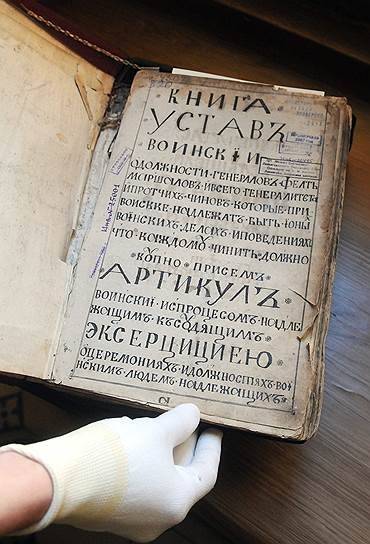
In 1716, the “Military Charter” was introduced. A significant place in it was also given to the training of soldiers for bayonet fighting.
In addition, the statute stated that for any shooting, everyone must necessarily adjoin the bayonets, since after it they will certainly go to the enemy with bayonets. That is why the three-sided bayonet lasted for so long in service with the Russian army. Although the bayonet must be constantly attached, but at the same time it made it possible to load the gun safely for the shooter. These requirements are suitable only for a three-edged bayonet, which has a long neck, diverting the bayonet wedge from the muzzle to a distance that is safe for the hand when loading. In this case, the face turned to the muzzle cut should not be sharp. These requirements are well satisfied with a triangular bayonet with a flat face facing the muzzle.
Thus, the foundation of tactics was laid. And A.V. brought her to perfection. Suvorov. He, following the path already planned in the Russian army by Peter I, found a solution to the problem that turned out to be insoluble for the military art of Western Europe of his time. At first glance, the essence of his transformations in tactics was very simple, but their significance was enormous.
First of all, Suvorov understood more clearly than any of his contemporaries that the composition of the Russian army and the qualities of a Russian soldier make it possible to educate in the army the properties necessary for the most decisive form of combat for combat with melee weapons. Suvorov found further the necessary methods of educating and training troops in the indicated direction. And finally, Suvorov found the right way to use infantry trained and trained in his spirit in combat, the essence of which was that the bayonet strike was put in the forefront as the decisive act of combat.
Instead of a fire contest with a very slow, not brought, as a rule, to the impact of rapprochement, which resulted in an attack on the methods of Western European tactics, Suvorov's infantry, after a short fire training, began a non-stop forward movement, which ended necessarily with a throwing bayonets. The fire had to partly upset and demoralize the enemy, disorganize its fire and reduce its effectiveness. In addition, the smoke from the shots served as a kind of disguise for the attacker. When attacking without fire preparation, the defender, shooting more calmly, had a chance to inflict heavy casualties on the attacker, or even easily repulse the attack.
At this point, the commander’s famous phrase comes up in the memory of many: “The bullet is a fool, the bayonet is good!” I’ll dwell on it in more detail, since recently these words are sometimes used to illustrate the backwardness of the Russian army.
In the original, the words of A.V. Suvorov in “Science to win” sounds like this: “Take care of a bullet for three days, and sometimes for a whole campaign, as there is nowhere to take. Shoot rarely, aptly; Bayonet if firmly. The bullet will obmishulitsya, the bayonet will not obmishulitsya: bullet - a fool, a bayonet - well done. This fragment as a whole completely changes the understanding of the phrase that is usually illiterately snatched from the works of the commander. The commander only calls to take care of the ammunition and shoot accurately and emphasizes the importance of the ability to work with a bayonet. The era of muzzle-loading weapons made it necessary to try to shoot accurately, the importance of accurate shooting was underestimated. But - let us emphasize once again - the fire of the infantry in Suvorov played the role only of preparing the strike. Perhaps most clearly, this is stated in the order of 1794 g .: "A step backward is death, all shooting ends with bayonets."
Thus, Suvorov, without abandoning the rational use of all the properties of weapons, decisively broke with the overestimation of the gunfire that prevailed at that time.
In the future, despite changes in the tactics of the troops and armament, he did not surrender the bayonet positions in the Russian army. On the contrary, bayonet fighting along with gymnastics is becoming increasingly important in the individual training of soldiers.
The Rules for learning to use the bayonet and butt in combat, published in 1857, emphasized that the leaders of the classroom should focus on the individual training of each warrior. For training in bayonet combat, layouts of rifles with a “soft and pliable tip”, masks, breastplates and gloves were provided. All techniques, ultimately, worked out in full gear. At the final stage of training, it was necessary to conduct free-to-face fighting, but the methods of fighting with the butt were also set forth; in addition, there were instructions on the tactics of actions in hand-to-hand fighting with several opponents or with fighters armed with various weapons.
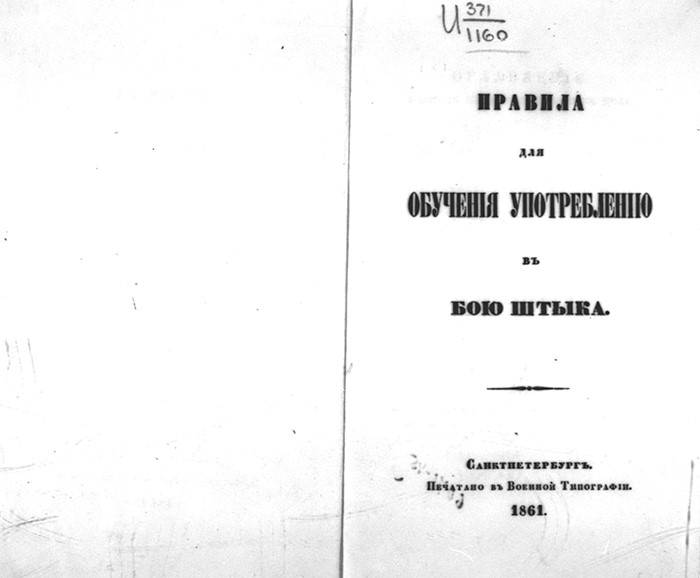
In 1861, new “Rules for the use of the bayonet in battle” were published, consisting of four parts, which provided for daily training sessions on bayonet fighting.
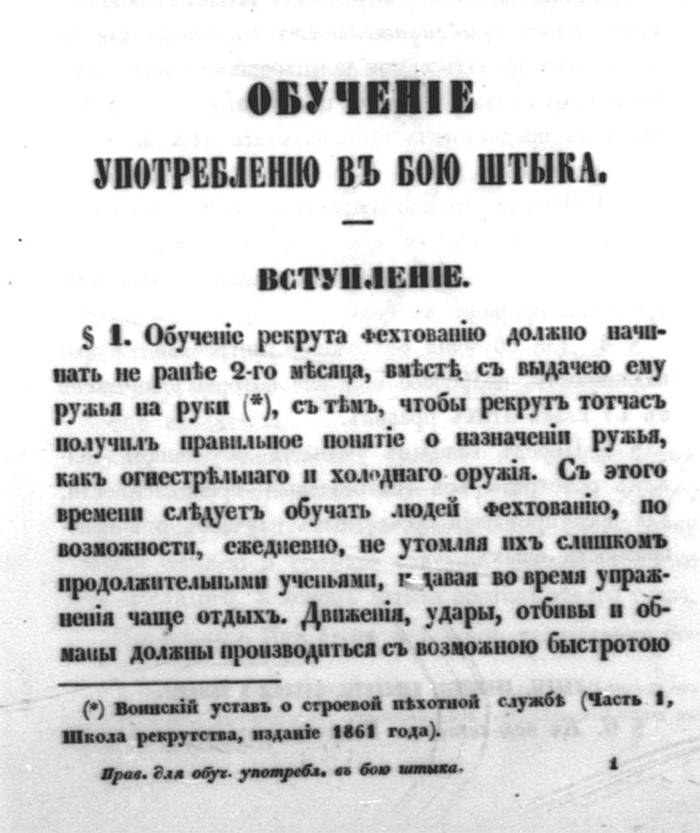
"Rules for the use of the bayonet in battle"
In 1881, new “Rules for learning to use in combat bayonet” were released, which have been in use for over 25 years. And only in 1907, it was replaced by the new “Training for bayonet fighting”.
Here you can ask the question that if the presence of a constantly sided bayonet for weapons of the 18th and 19th centuries can be explained, then how can this be explained for a rifle that was already being developed on the threshold of the 20th century.
An explanation of this can be found in the book, which served for many years as a desk for many military leaders of Russia. This is “Tactics Tutorial” written by General M.I. Dragomirovym in 1879 year. M.I. Dragomirov is the largest military theorist of the Russian Empire of the 2 half of the XIX century. His practical and scientific journalistic activities had a huge impact on all aspects of military activities, but, unfortunately, not always positive.
He expressed his vision of the development of firearms as follows: “... the bullet and the bayonet do not exclude each other, but complement each other: the first paves the way for the second. This relationship between them will always remain, no matter how far the improvement of firearms goes. ”
Authoritative sermon M.I. Dragomirova was vividly reflected in the 1904 Field Regulations and in other statutes of that time and had a considerable negative effect on the armament of the Russian army and its supply with modern technical means of combat. For example, even in the last Field Service Charter, approved in 1912, Suvorov’s “Teach a Soldier Before a Battle” survived, in which there were such “guidelines”: “He beats in battle, who is harder and bolder, and not who is stronger and more skillful” ; "Climb forward, even the front and beat"; "Do not be afraid of death"; “An enemy can be beaten either with a bayonet or with fire; of two, the choice is not difficult”; “If the enemy is close, always bayonets; if far away, first fire, and then bayonets. ”
It can not be said that the Russian army did not realize the archaic nature of the constantly attached bayonet.
Thus, the Minister of War DA Milyutin, in his diary in 1874, wrote: “the issue of replacing bayonets with hexes was again excited ... following the example of the Prussians. Three times this issue has already been discussed by persons competent: everyone unanimously gave an advantage to our bayonets and refuted the sovereign's assumptions that the bayonets adjoined the guns only at the time when the need arises to act with cold arms. And despite all the previous reports in this sense, the question is raised again for the fourth time. ”
At the beginning of the 20th century, there were two parties in the military circles of the Russian Empire. Some recognized the "bayonet" - a sign of courage, spirit, courage - and argued that, whatever the perfection of technology and the power of fire, the main thing in the war will be a man, that what matters is not a weapon, but a man with his determination, and that as a representative of this quality is the bayonet, the Suvorov aphorism “bullet is a fool, the bayonet is good,” is eternal. Others, passionate about the power of modern fire, gave an exaggerated importance to technology, denied the "bayonet", and with it the Suvorov aphorism.
M.I. Dragomirov dubbed the first "bayonets", the second - "fire worshipers." The first, led by Dragomirov himself, remained victorious.
Continuing altercations of “bayonets” and “fire worshipers” led to a vagueness of understanding the issues of “bullet” (matter) and “bayonet” (spirit), to false conclusions of the theory and, consequently, to the wrong preparation of the matter for war, to excessive enthusiasm for the moral side of preparation troops to fight to the detriment of military equipment.
As you can see, at the time of the creation of the trilinear, the bayonet positions were unshakable. They remained unshakable, by the way, until the trilinear was removed from service. Therefore, the use of 7,62-mm rifle system Mosin arr. 1891 / 30 without a bayonet also not provided.
The workers 'and peasants' Red Army not only borrowed the method of using the bayonet from the charters of the tsarist army, it introduced various improvements in it, including taking into account the experience of foreign armies.
But at the beginning of the 1930-s, Malinovsky, head of the Red Army Directorate Directorate of the Red Army, wrote: “The experience of the war says that the bayonet fighting, and in any case readiness for it, is still very often the decisive element of the attack. The same experience testifies to the significance of casualties in hand-to-hand combat, both because of the attack of the bayonet and because of the inability to use the bayonet. ” Therefore, it is not surprising that the RKKA Infantry Battle Regulations taught the fighters: “The ultimate infantry combat mission in an offensive battle is to smash the enemy in melee. Every attacker must choose a victim in the ranks of the enemy and kill her. No one who gets in the way should be left unattended, be it running, walking, standing, sitting or lying. ... Now there is no doubt that in many attacks, and in the night ones - surely, our opponents will seek victory in the bayonet strike, and therefore we must be able to withstand this blow with our more crushing blow. The experience of the war showed that many soldiers were killed or wounded only because of the inability to use their weapons properly, especially the bayonet. Bayonet combat is the decisive factor of any attack. He should be preceded by the last opportunity shooting. The bayonet is the main weapon of the night battle. ”
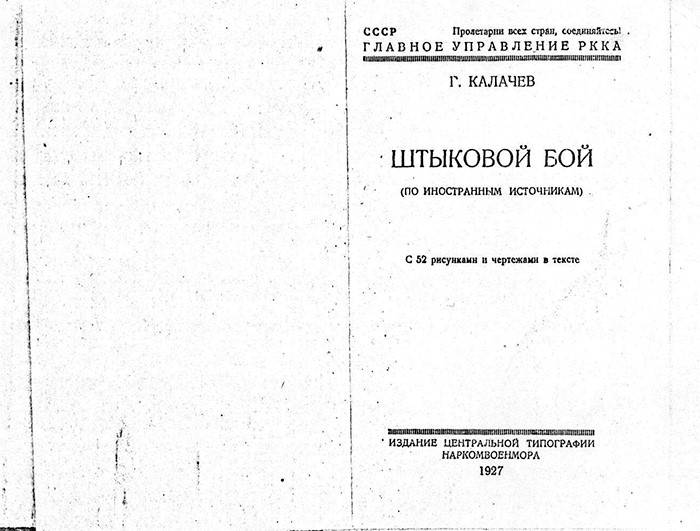
Unsurprisingly, the last pre-war “Manual on small-scale business” of the NSD-38 1938 of the year differs little from the “Manual for training in shooting” of the 1897 already reviewed by us.
And what about during World War II?
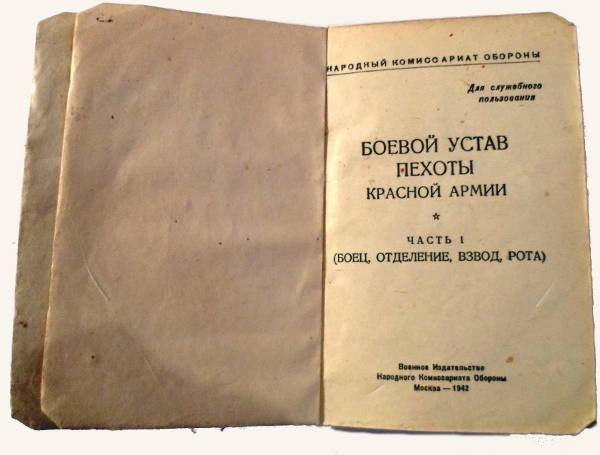
Battle Regulations infantry of the Red Army. 1942 year. Considered the experience of the first, most difficult year of the war.
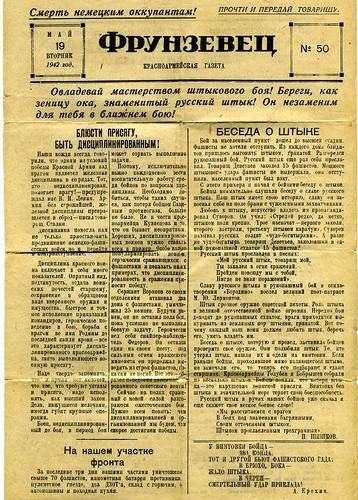
And this is the number of the newspaper of the Academy of the Red Army. Mv Frunze from 19 May 1942 of the year.
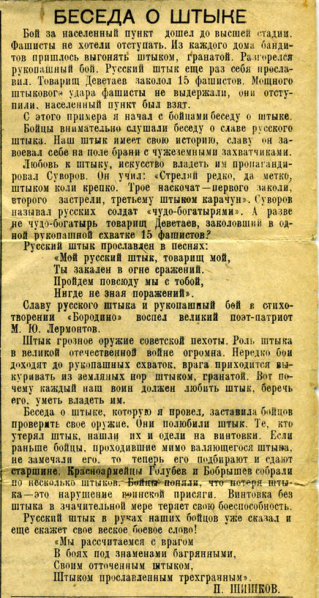
An editorial from this newspaper. Add to it too much and nothing.
To be continued ...
Information